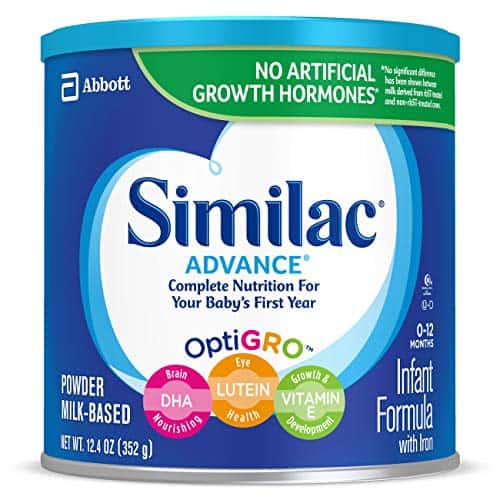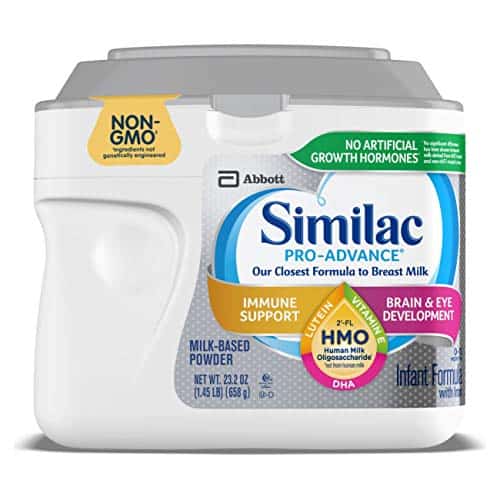Difference Between Similac Advance and Pro Advance
In this article we will discuss the difference between Similac Advance and Pro Advance.
So you’ve had a new baby, congratulations! In a new world full of diapers, bottles and pacifiers, many parents would be forgiven for their confusion over which of the huge range of baby formulas would be most appropriate for their child.
We will compare two popular and similarly sounding available from Similac; Advance and Pro-Advance. Hopefully by the end of this article, you will feel more confident about choosing which one is right for your child.
What is baby formula?
Baby formula is a product, usually made from cow’s milk, treated in such a way that makes it suitable for the special nutritional needs of a child under 12 months old. Typically found in a powder to be made up into a liquid with water (although some already come in liquid form for your convenience), baby formulas are popular with at least 30% of parents opting to exclusively bottle feed from day one.
As your growing child needs just the right balance of nutrition to support their growth, baby formulas are often fortified with the correct vitamins and minerals they require. In fact, the US Food and Drug Agency (FDA) states that all formulas produced in the US must include vitamins A to E and K, sufficient carbohydrates for energy and much more [1]. For this reason, for babies under 12 months, regular cow’s milk is not suitable to meet their needs.
Breast milk naturally provides your baby with all the nutrition it requires but breastfeeding is neither suitable or desirable for all parents. Instead, it’s a highly personal decision whether to breast or bottle feed. That is why baby formulas can be viewed as an alternative that tries to mirror the contents of breast milk.
What is Similac Advance
According to Similac, their Advance formula is designed to provide “complete nutrition for your baby’s first year”. Closer inspection of the ingredients reveals that in addition to its cow’s milk base which provides the right amount of fat and carbohydrate, Advance contains Similac’s unique OptiGRO blend of nutrients.
Specifically, OptiGRO contains vitamin E (an antioxidant benefiting developing cells), docosahexaenoic acid (DHA) (an omega-3 fatty acid for health nervous system development) and lutein (another antioxidant found in the eyes and brain to both develop visual processing and protect the retinas from harmful blue light). It is also fortified with iron to promote healthy red blood cell development, preventing anemia.
Similac Advance is one of the most popular formulas on the market for babies not being exclusively breastfed. In addition, unlike some brands, Similac does not add additional sugar to their formula. While there are some naturally occurring sugars in the cow’s milk required for growth, the lack of additional sugar means it is less likely baby will get accustomed to the taste of sugar, potentially promoting healthier habits when it comes to weaning and beyond.
Similac Advance Review
With an average rating of 4.7 out of five, Similac Advance scores highly going by reviews on major vendors including Walmart, Babies R Us, Amazon, Target and Walgreens. Like all products, reviews highlight the pros and cons to be taken into consideration.
Overall, users of Similac Advance found the following:
Pros
- OpriGRO blend provides nutrients essential for healthy brain and eye development
- Fortified with iron
- No added sugar
- Available in both powder and ready-to-feed formulations
- Readily available in most stores at a reasonable price
- Contains no growth hormones
Cons
- May cause gas and upset stomach
- Contains genetically modified material
- Not suitable for a vegan lifestyle
What is Similac Pro Advance?
With a similar sounding name, you can expect to find the same great benefits in Pro Advance as in Advance formula milk. With the same patented OptiGRO blend, Similac Pro Advance provides complete nutrition for babies under 12 months.
This time, according to their website, Similac market this formula as their “closest to breastmilk”. This claim comes from the addition of 2′-FL Human Milk Oligosaccharides (HMO). HMOs are complex sugars found in human milk and interestingly, the chemical structure of HMOs is unique to each individual mother!
As breastmilk’s third most abundant component, HMOs play an important role in supporting you baby’s developing immune system and encourages the growth of the flora or “good” bacteria in the baby’s gut needed for effective digestion as the baby gets older.
Respected studies [2] have demonstrated that comparing the gut flora of babies that received milk containing HMOs to those without, the HMO group had a gut flora more similar to breastfed babied at three months. Up until recently, only breastfed babies could benefit from HMOs but now Similac has made it possible for your formula fed little one to benefit too!
Another difference that you may want to consider is that Pro Advance uses no genetically modified organisms (GMOs) in its formula. GMOs have gotten a bad press over the years with opponents of GMOs stating that this method of agricultural production has negative impacts on the environment. Regarding human health, there is the concern that genes from GMO foods may cross to gut bacteria or human cells, potentially causing negative effects. It is worth noting though that the World Health Organisation (WHO) states that the chances of this happening are very small.
A full review of all the general pros and cons of GMOs are beyond the scope of this article but you may want to read more about this if it will inform you decision. A well-balanced account of GMOs can be found on the FDA website [3].
Similac Pro Advance Review
Across the same major vendors, there are fewer reviews for Pro Advance than Advance, perhaps reflecting the fact that it is a newer product. However, it still performed well with an average of 4.3.
Pros
- Even closer to breastmilk with the addition of HMOs
- Also contains Similac’s OptiGRO blend of essential nutrients
- Contains no GMOs
- Available both as powder and ready-to-feed liquids
Cons
- Not found as easily in stores but can be found online
- More expensive than Similac Advance
- May cause wind and stomach upset
Similac Advance vs Similac Pro Advance – Conclusion
So, let’s round up our comparison of Similac Advance and Pro Advance. Both of these formula milks are popular choices with parents worldwide. Both contain the same number of calories (100 per 5 fl oz serving) which is roughly equivalent to the content of breastmilk. They both provide total nutrition suitable for babies who are exclusively bottle fed and their patented OptiGRO blend will again give the nutrients your baby needs.
Pro Advance benefits from the addition of 2-FL HMOs which you will recall are naturally occurring sugars found in human breastmilk that can help develop baby’s immune system and gut flora. However, whilst HMOs may well change the flora of your baby’s gut to something more akin to a breastfed baby’s, it is worthwhile noting that this does not necessarily translate to a clinical benefit to the baby. Synthetic addition of HMOs to baby formula is something that the scientific jury is still out on.
As discussed previously, the choice to include GMO products in you and your child’s diet is a very personal one. The concerns about the environment are legitimate but then again you might ask whether the use of GMOs is better than the use of chemical pesticides. GMOs can sidestep these pesticides by being engineered to produce their own pesticide.
Additionally, it is worth keeping in mind the prevalence of GMO technology worldwide. The USA is the world’s biggest producer of GMO crops with a huge 94% of its soybean, corn and cotton crops having some form of genetic modification in 2020 [4].
The additions that Pro Advance has do come at a cost. On average, you can expect to pay around five dollars more for Pro Advance than Advance. Again, it is very much a personal decision. Those extra five dollars do add up over time and for some parents, this may be enough for them to stick with the Advance formula, especially if they are sticking to a budget.
Regardless of which formula you choose, you can be reassured that both are great options for your baby’s growth and development in those critical first 12 months.
Can you mix Similac Advance and Pro Advance?
Still can’t decide which of these two formulas to use? Whilst it will not harm your baby, it is inadvisable to mix the two. First, both formulas have slightly different tastes with Pro Advance being described as having a more “sharp” and “tinny” like taste although very subtle. If your baby is particularly sensitive, they may not like the mixture of two different tastes combined.
Another reason not to mix the formulas is that if one does not agree with your baby or they just don’t like it, you won’t know which of the formulas is the culprit. A trial and error approach is better, seeing how you baby gets on with one formula alone for a few weeks before switching.
Different Variations
Judging by the reviews, both Advance and Pro Advance can cause a bit of wind and stomach upset. This is common to many formulas and can even happen with breastmilk! The most explanation is the immaturity of your baby’s gut but it can sometimes be an indication of an allergy. If the symptoms persist, it might be worthwhile talking to your healthcare provider to rule this out
If your baby is suffering from this common problem, you could explore using Similac Sensitive or Similac Pro Advance Comfort, both of which are said to be easier to digest, alleviating gas and spit-up by using milk protein that has already been partially digested or hydrolysed for your baby.
As with Advance and Pro Advance, these so called “comfort milks” contain the same OptiGRO blend found in Advance and Pro Advance Comfort with additional iron meaning they can both provide the same complete nutrition without uncomfortable side effects. Whether or not you choose Sensitive or Pro Advance Comfort again depends on your feelings towards GMOs, HMOs, and your budget with the former containing GMOs and no HMOs but kinder on your wallet.
If the environment and “naturalness” of products you feed your baby are of particular concern to you, you may want to consider Similac Organic formula. Again containing OptiGRO, the products in this milk are not only non GMO but also certified USDA organic. This means it contains no antibiotics, herbicides or synthetic fertilizers. Yet again, this is a personal choice.
Similac Ready-To-Feed
As mentioned previously, all of these Similac milks are available in a powder that you reconstitute into milk by adding water. If using powder, be sure to follow the instructions on the side of the tub as too little water may lead to your baby becoming constipated. Remember, this is their main source of not only food but water too!
Sometimes, making up a formula isn’t practical, for example on trips out or if fresh clean water is not available. In these circumstances, you might be better off buying Ready-To-Feed which is conveniently pre-mixed. All you need to do is to pour the milk into a sterilized bottle and you are good to go! These bottles can be bought by the case as several single serving bottles or as larger bottles containing multiple servings.
If you do go for Ready-To-Feed, do bare in mind that it works out a little more expensive than the powder if you are working to a tight budget. Also, if you are environmentally minded, the bottles containing Ready-To-Feed will generate more plastic waste, especially the single serve ones. Again though, I stress, this is a highly personal decision.
References
- FDA (2020) Infant Formula – Nutrition Requirements [online] available from: https://www.accessdata.fda.gov/scripts/cdrh/cfdocs/cfcfr/CFRSearch.cfm?fr=107.100
- Steenhout P., Sperisen P., Martin F.-P., Sprenger N., Wernimont S., Pecquet S., Berger B. (2016) Term infant formula supplemented with human milk oligosaccharides (2′fucosyllactose and lacto-N-neotetraose) shifts stool microbiota and metabolic signatures closer to that of breastfed infants. J. Pediatr. Gastroenterol. Nutr. 2016;63:S55
- FDA (2020) Agricultural Biotechnology [online] available from: https://www.fda.gov/food/consumers/agricultural-biotechnology
- M.Shahbandeh, (2020) Percentage of genetically modified crops in the U.S. by type 1997, 2018, 2019 & 2020 [online] available from: https://www.statista.com/statistics/217108/level-of-genetically-modified-crops-in-the-us/












